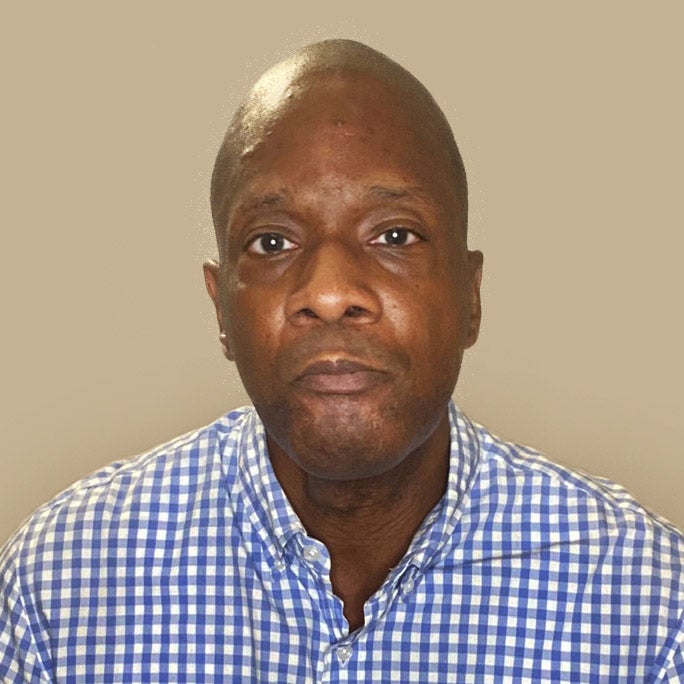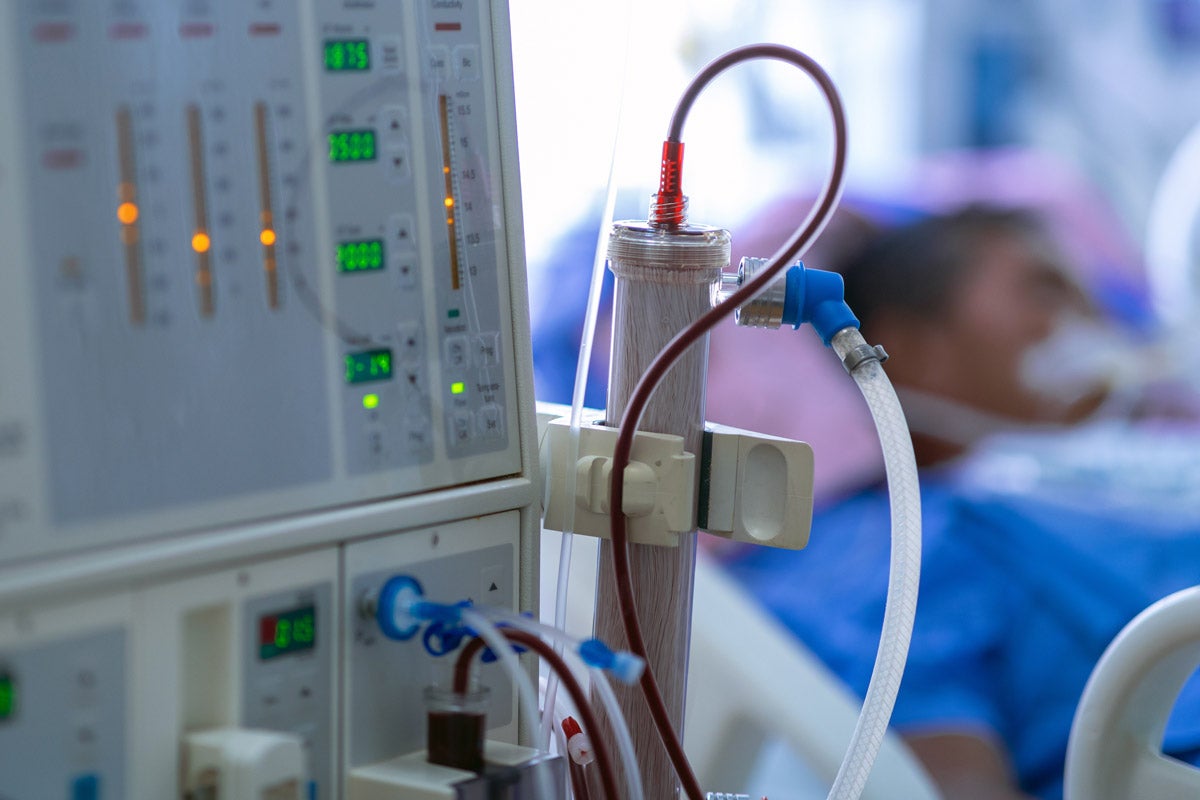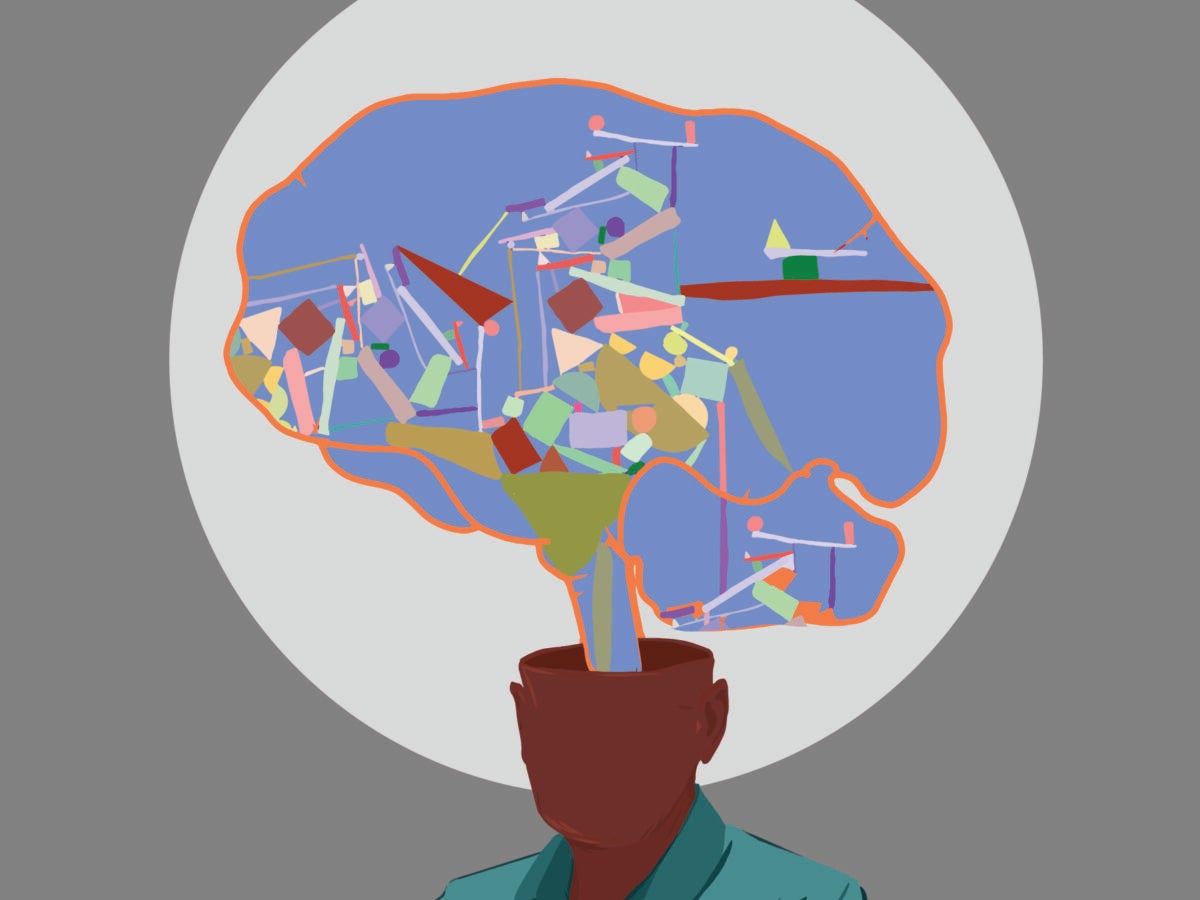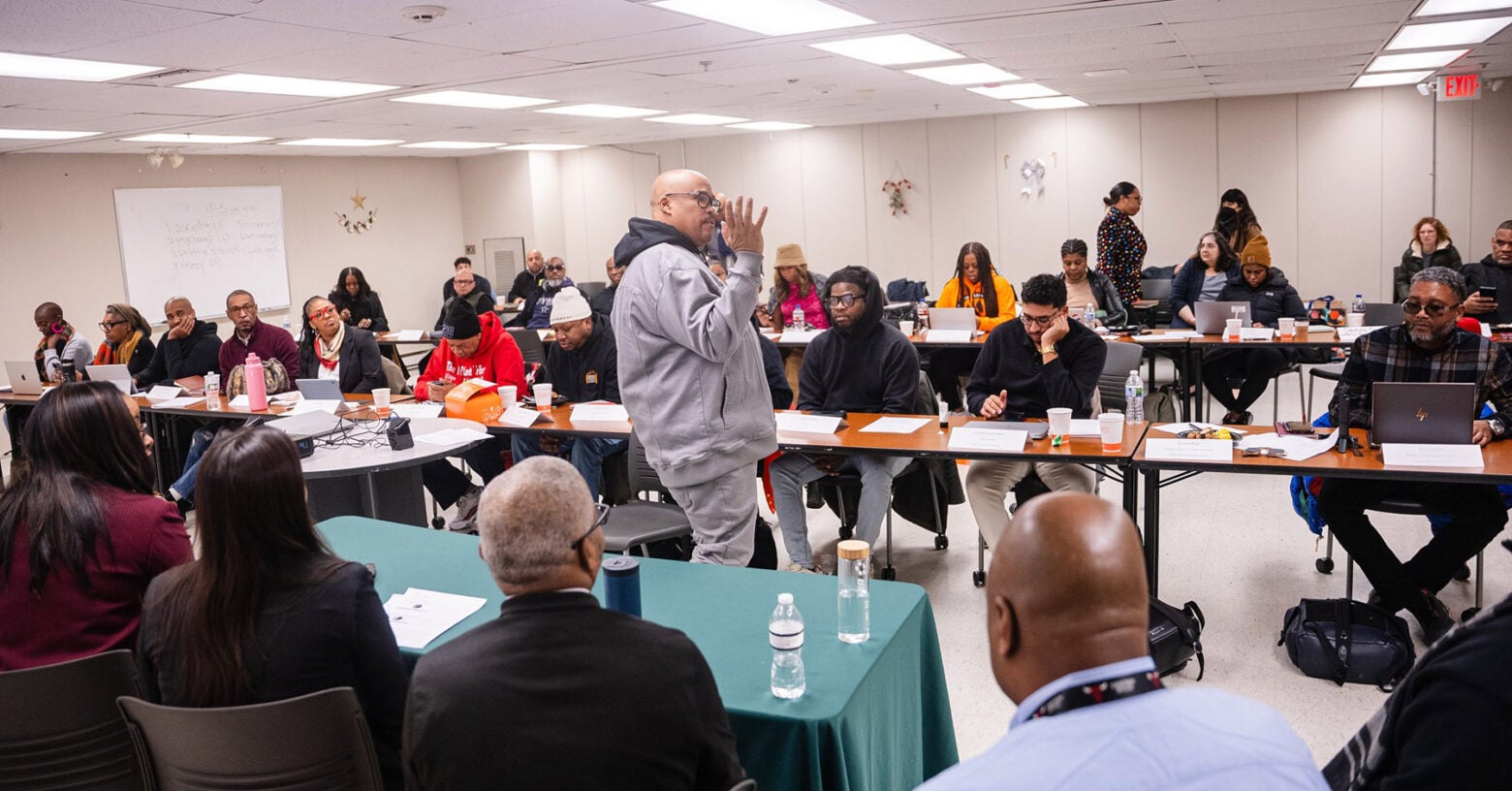
Feature
No research about us without us?
Lupe Washington’s job description does not include “public health scientist,” but it should. Washington is director of community health and violence prevention for the public health department of Harris County, Texas, which includes Houston, the nation’s fourth-largest city. She is also part of an ongoing community-based research project looking at ways to improve programs like the one she runs.
She’s part of a trend in public health research, in which researchers involve people from the communities they study. Public health research often focuses on population data sets, which means the research can seem detached from the public itself, especially if the results take a long time to trickle down to the community. This is particularly true for marginalized communities, which are not typically consulted on their needs, priorities, and expectations.
Community-engaged research helps to change that. The work is complicated, but over the past three decades, numerous studies have demonstrated that community-engaged research reduces health disparities and improves public health outcomes. Public health researchers, health care providers, and policymakers have increasingly relied upon the approach to address stubborn but critical public health challenges such as infectious and chronic disease, maternal health, and gun violence.
Sign up for Harvard Public Health
Delivered to your inbox weekly.
Washington says it makes sense for researchers to collaborate with communities and vice versa. She says working together gives the research a “human-centered design” that improves understanding of public health challenges and eases crafting solutions, especially for groups that are often overlooked. “We must work with people from the communities to better serve them,” she says. As a violence intervention strategist, she has welcomed the chance to apply lessons from previous studies on community gun violence interventions while informing a future study.
What matters most in community-engaged research is seeing it put into practice, which generally means including the voices of those affected by the research, says Kimberly Parker, an Atlanta-based public health strategist. Parker has conducted qualitative and quantitative research on health inequities, including on HIV/AIDS and COVID-19. She says it is important to keep researchers and stakeholders accountable to each other and to understand which interventions communities need and request.
Community engagement can often yield strong results because the researchers are working in tandem with the community. “At least for communities of color, folks are expecting this now,” says Shoba Ramanadhan, a behavioral scientist at the Harvard T.H. Chan School of Public Health. “They’re not interested in your $25 incentive to fill out a survey” if that is the only interaction they’ll have with researchers.
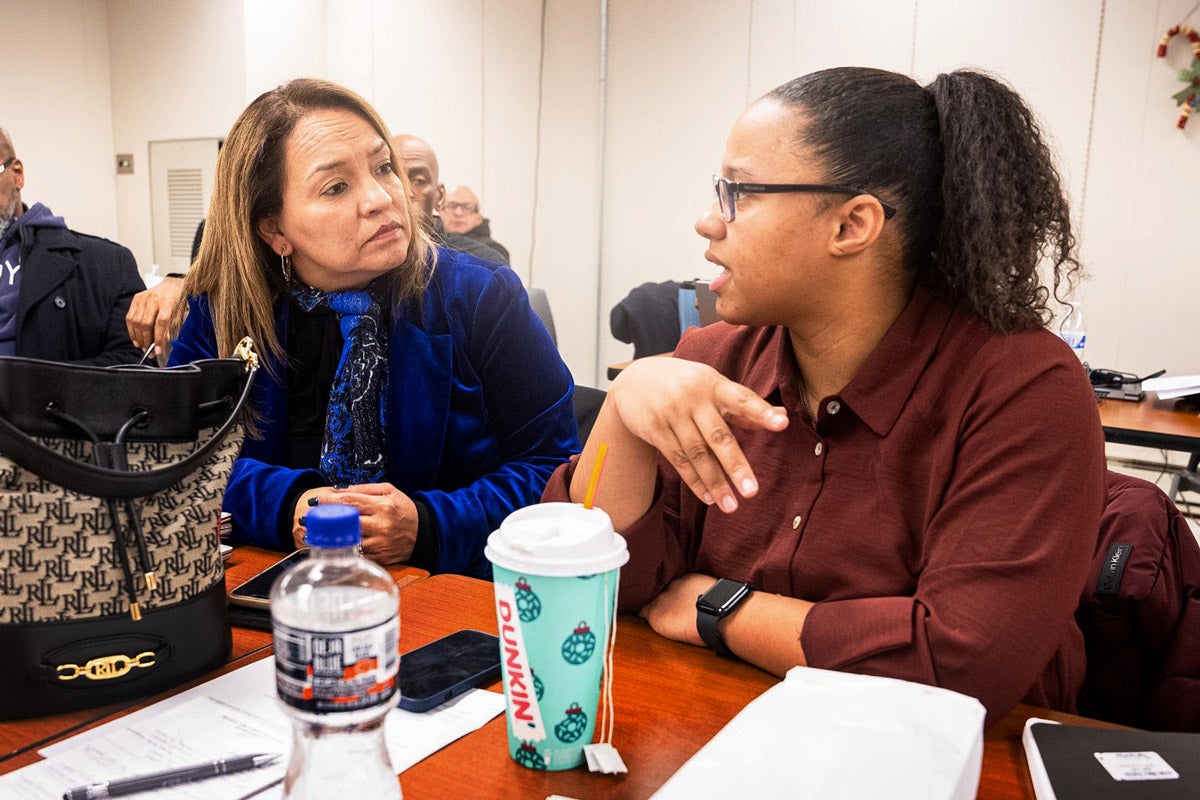
Lupe Washington (left), director of community health and violence intervention in Harris County, Texas, talks with Alivia Langley of Connecticut Violence Intervention and Prevention during a session of the Community Violence Intervention Leadership Academy.
Beking Media for the University of Chicago Crime Lab
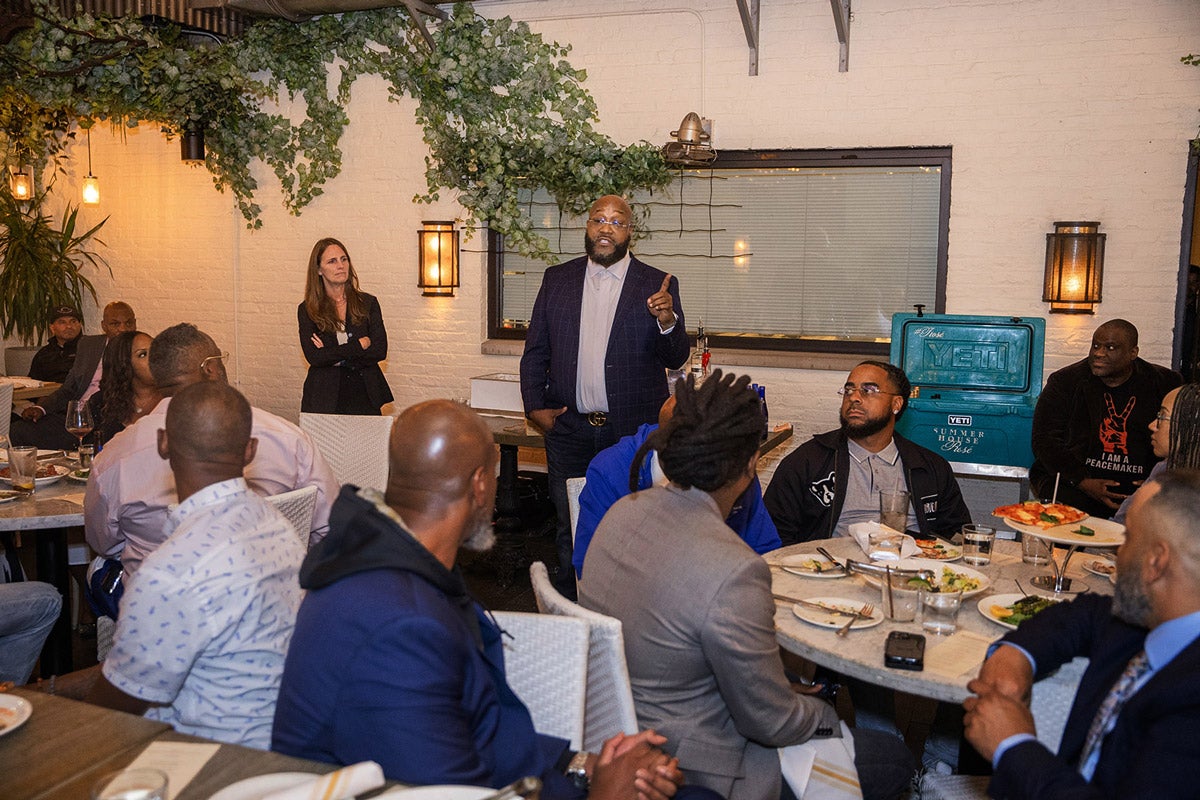
Chico Tillmon (center), executive director of the Community Violence Interruption Leadership Academy at the University of Chicago Crime Lab, and Roseanna Ander (left), founding executive director of the lab, speak with participants at a dinner event in Chicago, Illinois.
Beking Media for the University of Chicago Crime Lab
Ramanadhan has used the community-engaged approach for about 15 years in her research on cancer prevention and disparities. She says the challenges for researchers include needing to show their work, often while it is in process. And these projects require commitments of considerable resources and time.
Lorena Estrada-Martinez temporarily relocated almost 2,000 miles, from Boston to San Juan, Puerto Rico, to be closer to her research community. Her project is based in Vieques, an idyllic island that is home to the Caribbean’s largest natural wildlife refuge and one of only five ecosystems in the world with blue-green bioluminescent bays.
Estrada-Martinez, a social epidemiologist, leads an interdisciplinary research team working with 225 of the island’s roughly 8,000 inhabitants to assess health and environmental risks created by its other long-time occupant: a U.S. Navy bombing range.
The Navy operated the range between 1941 and 2003. When it closed its facility, the Navy left behind thousands of acres of land, sand, and sea contaminated by toxic substances such as napalm, heavy metals like depleted uranium, and unexploded ordnance. The residents of Vieques have high rates of lung, colorectal, and several other cancers.
The residents and many researchers, including Estrada-Martinez, say the environmental hazards and cancers are linked. Proving the link has been difficult, even though one study found that women under age 50 on the island have a 280 percent higher rate of lung and bronchus cancer than those in Puerto Rico.
Estrada-Martinez’s study is funded by the U.S. Environmental Protection Agency, which specified using a community-based participatory research approach to identify overall health and contamination exposure on Vieques and to investigate cleanup and mitigation solutions. Among the principal investigators are a biologist, a chemist, a toxicologist, a sociologist, and an epidemiologist, most of whom are Latina or Latino and aware of the unique history and challenges in Puerto Rico—including what happened over three weeks in September 2017, when Hurricanes Irma and Maria devastated Puerto Rico, cutting off electricity and running water for almost the entire territory for up to six months. The lack of electricity and diminished access to quality health care exacerbated already high rates of health conditions such as asthma, cancer, diabetes, and high blood pressure and intensified years of out-migration by health care providers and specialists. Between 2009 and 2020, almost one-third of the Puerto Rico’s physicians left the island.
Estrada-Martinez grew up in Boston and San Juan, and she has family near Vieques, so she’s familiar with the area’s social, public health, and environmental concerns. Her family and social ties to the area made it important to get both the research and the solutions right, she says, as has the experience of some of the cancer patients dying during the research.
Even with her connections to Vieques, it took the team about nine months of collaborating with different community groups to create a steering committee to guide the research and roughly 18 months to launch the project. Two-thirds of the committee members are from the community, and the rest are from the research team. Together, they decided the study would focus on cancer.
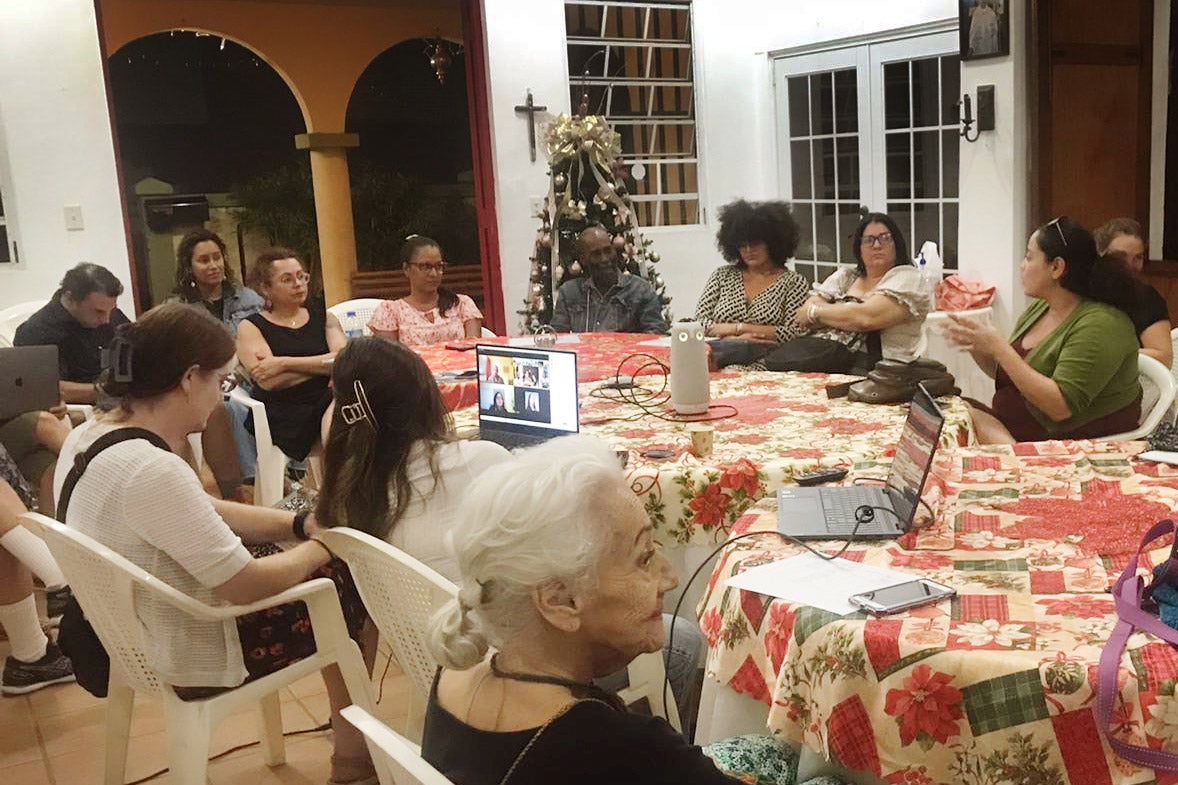
The steering committee for a community-engaged research project on the long-term effects of a U.S. Navy facility meets in a church in Isabel Segunda, Puerto Rico. The project is co-led by Lorena Estrada-Martinez (right), a social epidemiologist at the University of Massachusetts Boston.
Pamela Gonzalez
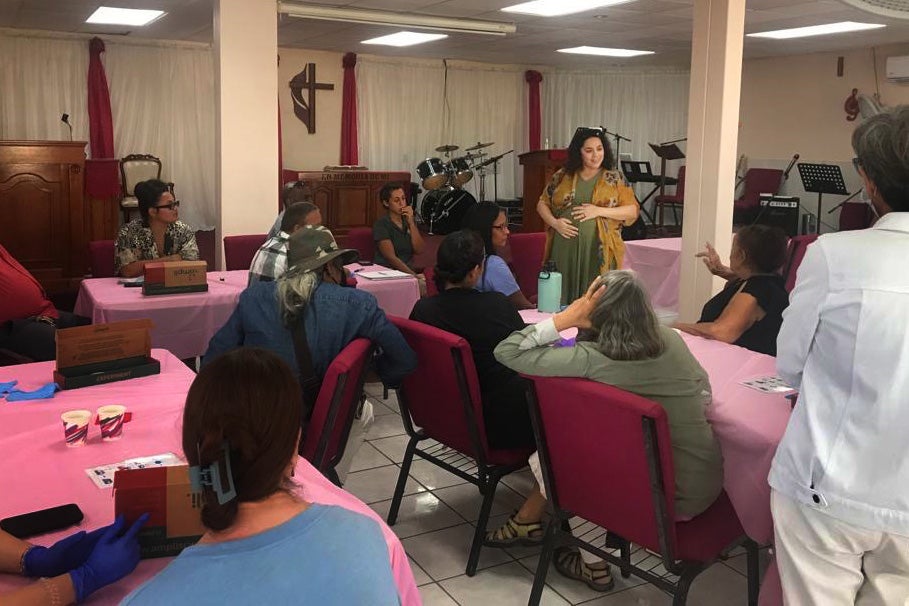
Estrada-Martinez speaks at workshop on Vieques, Puerto Rico, where residents learned how to apply sensor technology for a community-engaged research project.
Pamela Gonzalez
“They helped us to map where we would sample contaminants” in the ocean, sand, soil, and food chain, says Estrada-Martinez. For example, because crabs are important to the local diet, the community was very interested in testing the crab population. The researchers worked with crabbers to catch and sample the shellfish. “It has been a very productive relationship,” she says.
This summer, the researchers completed 225 interviews of residents, documenting histories of family health and cancer occurrence. They hope to combine this information with maps of contaminated sites and DNA analysis to better understand when and where residents might have been exposed.
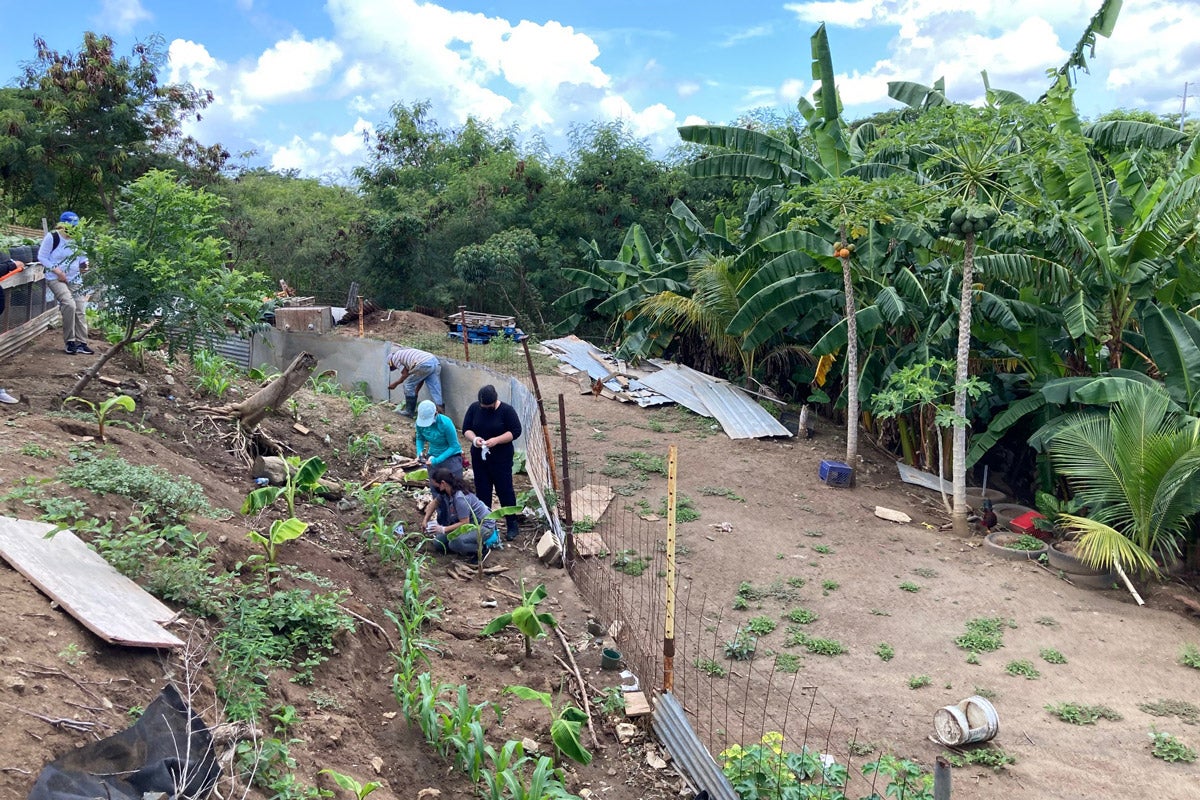
Soil samples being taken at Finca Quiro, Puerto Rico in July 2021, as part of a community-engaged research project examining the long-term impact of a U.S. Navy bombing range
Adán Colón-Carmona

In Vieques, researchers spent time at Finca Conciencia, a farm and food sovereignty advocacy group founded by Jorge Cora, a member of the steering committee for a community-engaged research project. Cora (third from right) is pictured here with other researchers on the project.
Adán Colón-Carmona
A “gold standard” for community engagement
The Vieques project sits at one end of a spectrum of researchers’ approaches to working with communities. The affected community has an equal voice and shares knowledge and decision-making at every step of the process, from conception to participant recruitment to how the data is analyzed and released. This approach, known as community-based participatory research (CBPR), is considered the gold standard for community-engaged research because the community drives the agenda.
There is disagreement about whether this level of collaboration is required to call a project community-engaged research. The goals for community-engaged research are, broadly, partnering with affected communities, building trust and long-term relationships, encouraging healthier behaviors and outcomes, and influencing evidence-based public health policy, according to the framework refined by Nina Wallerstein, director of the Center for Participatory Research at the University of New Mexico.
But in practice, community-engaged research exists on a continuum. At one end, researchers don’t interact with community stakeholders and residents but may inform the community of their intentions. In the middle of the continuum, researchers may consult with community stakeholders but will not directly involve them in their work or decisions. But who defines what “community” and “community-engaged research” look like is a crucial question, according to stakeholders such as Estrada-Martinez, to make sure that projects address the correct audiences with interventions tailored to their needs, expectations, and histories.
“At least for communities of color, folks are expecting this now.”
Shoba Ramanadhan, behavioral scientist at Harvard T.H. Chan School of Public Health
Challenges to collaboration
Many community-based participatory research projects struggle to create the close collaboration that the Vieques researchers and residents have achieved.
One reason is a lack of clarity about what it means to involve participants, says Soroya Julian McFarlane, a health communications researcher at the University of Georgia. A systematic review McFarlane and her team published in 2022 found an increase in the use of community-engaged research from 2010 to 2020 versus the previous decade. But the reviewed studies were inconsistent in seeking community input or involvement in decision-making.
The team reviewed a decade’s worth of CBPR in clinical trials that focused on communities of color and health problems such as diet, obesity, nutrition, chronic diseases, and cancers. More than 85 percent of the papers reported positive outcomes for the interventions studied. However, when the team delved into the extent of community involvement, they found that many studies offered minimal details. They observed that when such information was available, it pointed to a “top-down” approach that offered community members little power over decisions about the studies.
Systematic reporting about the extent of community engagement would help to raise awareness about the standards for CBPR, McFarlane says. “Did the community have an equal voice at every level from the research question to design to collecting data to the write-up?”
Another challenge to successful community-engaged public health research is making sure the community representation reflects the affected community, says Glenn Ellis, a Philadelphia-based medical ethicist, equity consultant, and bioethics research fellow at the Harvard Medical School Center for Bioethics. It is “only community-engaged research if it truly engages the community of interest,” he says, and that involvement is not merely symbolic. In some cases, says Ellis, researchers study “historic representations of communities, and none of those historic communities still look the same as they once did because of gentrification.”
Ellis notes that New York City’s Harlem was once a largely lower-income African American neighborhood, with high rates of diabetes and HIV/AIDS. But Harlem has gentrified in recent years, and some blocks or areas may no longer reflect the health of African Americans with low incomes. Researchers should consider casting a wider net, whether in different city communities or nearby suburbs, to be sure they reach the affected populations, he says.
Start with the leaders
Many public health researchers say that community-based research, when done right, can be a powerful tool to create change and sustained collaborations with the affected communities. Ramanadhan even describes her role as a principal investigator in a recent project as more “consultative” to the studied community.
The University of Chicago Crime Lab, which uses community-engaged research methods, was founded to be both academically rigorous and relevant to the community, says Roseanna Ander, the Crime Lab’s founding executive director. “What good is a place like the University of Chicago and all the Nobel Prizes that it likes to brag about,” she asks, “if the university is not contributing meaningfully to real-world circumstances in our home city … one of those being gun violence?”
The Crime Lab started researching community gun violence interventions in 2008, after a 29-year-old University of Chicago doctoral student was shot and killed in an armed robbery near his apartment. Since then, the researchers have developed long-term collaborations with communities and put theories of community-engaged research into practice.
While firearm violence affects every kind of community in the U.S., it is particularly severe among younger Black men in urban settings. Gun violence has surpassed auto accidents as the leading cause of death among people age 19 and under. Many researchers and agencies are seeking innovative, community-based interventions.
When gun violence surged 35 percent nationally during the pandemic, the Crime Lab wanted to spread lessons from its decade-plus of research. Accordingly, in 2023 the Crime Lab launched its Community Violence Intervention Leadership Academy, a first-of-its-kind program to educate and train leaders of public health and nonprofit violence intervention programs on techniques the Crime Lab has developed through its research. Both attendees and organizers see the five-month program as an opportunity to professionalize the field. It’s also a field research laboratory for studying the effectiveness of community-based interventions.
Harris County’s Lupe Washington was part of the first cohort of 31 participants from 22 cities, which began in September 2023. All of them were community violence intervention leaders working in communities of color disproportionately impacted by gun violence. Washington says she joined the program because she wanted to do a better job leading and inspiring her staff of violence interrupters, who are called “credible messengers;” to improve her network of peers; and to learn from what other cities are doing to reduce gun violence. Participants have their costs covered.
Washington started her current job in 2020. She supervises a staff of 18 credible messengers on three teams focused on community violence interruption, hospital violence interruption, and an alternative 911 program.
Early in October, she was in a classroom at the Chicago Theological Seminary, listening to Monica Bhatt lead the room in a case study on the Mayor’s Mentoring Initiative, launched by the Chicago mayor’s office in 2016. Bhatt, a senior research director at the Crime Lab, walked the participants through the details of the three-year, $36 million effort, a public-private partnership designed by the Crime Lab. Bhatt told them it was meant to help youth who are at-risk for committing or becoming victims of gun violence by connecting them with employment, mentoring programs, and other services. She explained that the program hoped to work with 7,200 young people, and then she asked, “Is there one organization in your home city that can offer services to 7,200 youth?”
The room was silent. After an awkward pause, Washington, a former juvenile probation officer, raised her hand and said, “Maybe the juvenile justice system?”
The irony sparked bursts of laughter from around the classroom. The moment of levity showed that even in the nation’s largest cities, few organizations can practice violence interventions to youth at a meaningful scale. It also highlighted that program design and stakeholders engagement—where the stakeholders are the community—are key considerations when developing public health interventions.
Over the next few weeks, Washington and the other participants traveled to sessions in Chicago, New York, and Oakland, California, where they learned program management, data literacy, and capacity-building skills. All of them worked on projects meant to enhance or develop their own gun violence intervention programs. The Crime Lab also created a steering committee to guide its research design, says Chico Tillmon, executive director of the leadership academy. Over the next three years, they will share their results with the Crime Lab so it can evaluate the effectiveness of the programs.
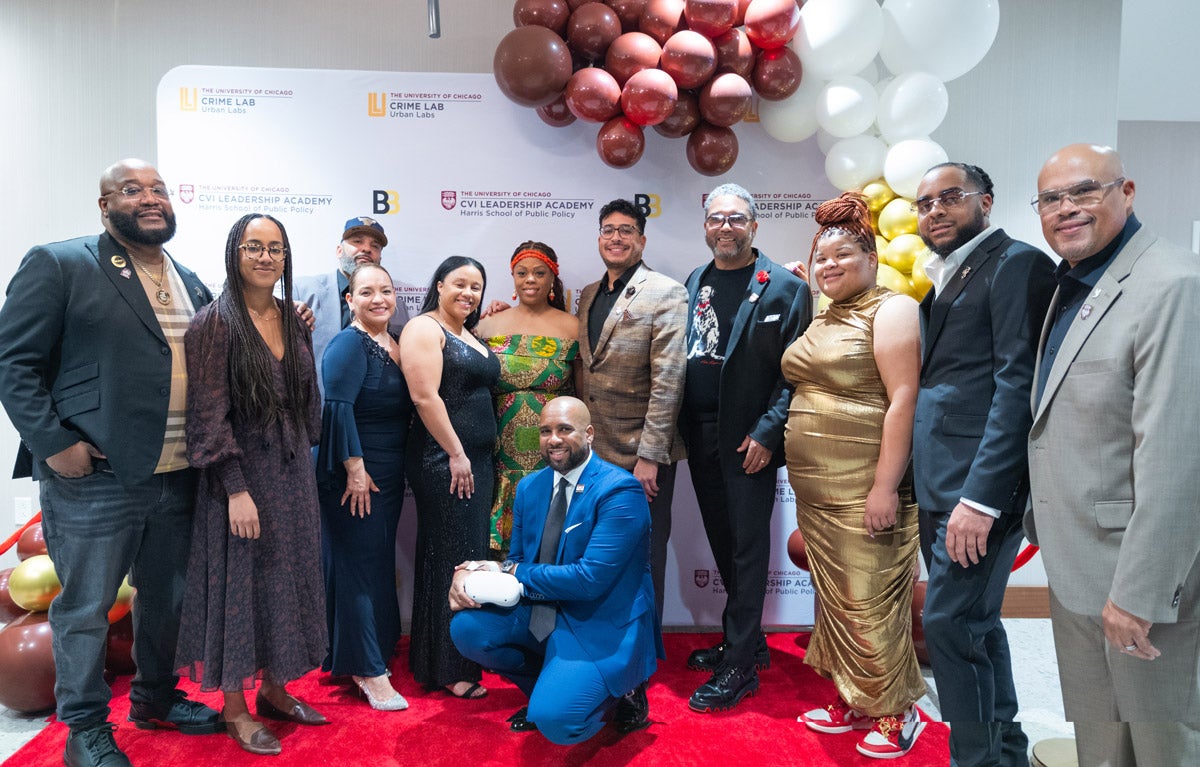
Chico Tillmon (left), Lupe Washington (middle row, third from left) and other Community Violence Intervention Leadership Academy participants and supporters at the academy's graduation reception in February 2024
Tarik Dennie for the University of Chicago Crime Lab
One outcome being studied is how to improve communication between violence interrupters and police. In Harris County, violence interrupters have long-standing relationships in the neighborhoods and are dispatched to de-escalate conflicts before they turn violent and guns become involved, be it on the streets, at schools, at social gatherings, at crime scenes, or at hospitals. Some of the Harris County credible messengers were once involved in street gangs or spent time in prison, which is common for violence intervention team members. Hiring people who have been arrested or incarcerated makes sense, says Washington, “because they know how to relate best to people who are at the highest risk of being perpetrators or victims of crime.”
But this can sometimes create tensions with police, says Mark Saint, the Crime Lab’s director of curriculum and learning.
Cities need innovative solutions such as community violence interventions, says Kim Foxx, the state’s attorney (equivalent to district attorney) of Cook County, Illinois. She runs the second-largest team of prosecutors in the U.S. and was one of the speakers at the leadership academy. Foxx thinks the project is important. “The work with community violence has gone from feeling charitable to a rigorous evaluation of what works. To be impactful—especially around leadership—we have to invest in the people who do this work.”
The program has already drawn national attention. The Community Violence Intervention Leadership Academy’s first cohort was recognized in February at the White House by its Office of Gun Violence Prevention, led by Vice President Kamala Harris, now the Democratic presidential nominee. Harris expressed hope that the graduates would make the lessons “real in a way that will be replicated around our country.”
The Crime Lab’s second cohort started in May, and a third will begin in December.
Local lessons from a national reckoning
Washington says both the training she received and the network she developed through the leadership academy will help her department’s work in Harris County. She is working on ways to expand the academy’s violence intervention programs both in the community and at hospitals. The latter, known as hospital-based violence intervention programs, engage medical and support staff with violence interrupters to ensure that gun violence victims and their families receive trauma-based care and conflict resolution tools. The bottom line: The goal is to keep victims and their families from retaliating and continuing the cycle of gun violence.
She says the Community Violence Intervention Leadership Academy gave her tools and space to develop a five-year strategic plan for making the county safer. In particular, she could begin to answer the question, “How does violence interruption in Harris County fit into the Harris County public safety ecosystem?” In the six months since she finished the leadership academy, Washington says she’s put research into action. “We are using all the concepts” from its training, she says. She’s also gathering data related to the impact of the changes and thinks the results will fuel expansions to the department’s violence prevention programs.
Top image: Marcus McAllister, dean of students at the Community Violence Intervention Leadership Academy, speaks to the academy’s inaugural cohort. Photo: Beking Media for the University of Chicago Crime Lab.
